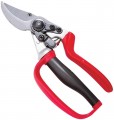Max. cutting diameter
The largest diameter (thickness) of a branch that the tool can handle.
The larger the maximum cut diameter, the more powerful this model, the lower the likelihood that a certain branch will be too tough for the tool. At the same time, note that to ensure high power, long handles and strong blades are needed, which accordingly affects the dimensions, weight and price. Therefore, it is worth choosing according to this parameter with a certain margin, but at the same time, this margin should not be too large.
As for specific figures, a maximum diameter
of 20 mm or less is considered relatively small, but it often turns out to be quite enough for simple work.
21 – 30 mm — the average value,
31 – 40 mm — above average, and in loppers the maximum thickness can
exceed 40 mm.
Rotary handle
This feature means that one of the handles of the tool is able to rotate around the longitudinal axis. Only single-handed secateurs (see "Type") are equipped with
a rotary handle, and the purpose of such a device is to optimize the position of the handle during work. The fact is that when working with one hand, the user's fingers not only squeeze the handles, but in fact also try to turn one of them; so that the handle, which can be rotated, does not slip under the fingers. This provides added convenience and minimizes the chance of blisters.
Ratchet mechanism
The presence of a
ratchet mechanism in the tool — a device known colloquially as a "ratchet". The principle of operation of such a mechanism is as follows: the blades of the tool can move in compression, but the reverse movement (in opening) is blocked by a gear wheel with a stop dog. This makes it easier to cut thick hard branches: the cut can be carried out in several stages, at each of them pressing the blades a few millimetres and not being afraid that they will move back. This way of working will be especially appreciated by users who do not have great hand strength. And in order to open the blades after cutting, you need to either unclench the handles with force, or vice versa, squeeze them all the way.
Finger loop
The presence
of a loop for the fingers in the design of the tool. Such a loop is used in one-handed tools: it is usually installed on one of the handles, four fingers are threaded into it, opposing the thumb. Such a device provides additional convenience and reliability in holding the tool (reduces the likelihood of letting it out of hand), and also provides some protection from branches and other foreign objects.
Handle material
—
Plastic. Relatively simple and at the same time quite practical, as a result — a common material. Plastic perfectly resists moisture, almost does not cool hands in cool weather, and is relatively inexpensive. As for strength and reliability, they are generally somewhat lower than those of metals, and most tools with plastic handles are designed mainly for simple work with relatively low loads. However, there are exceptions — for example, powerful loppers, which use high-quality durable plastic grades for handles. Anyway, for additional convenience, handles made of this material are often supplemented with rubber pads.
—
Steel. The key advantage of steel is its high strength, which makes it possible to use this material even in the most powerful tools designed for thick branches. Compared to another metal — aluminium — steel weighs a little more, but costs less. For additional resistance to corrosion and ease of holding, steel handles can be coated with paint or equipped with additional overlays, most often of rubber or plastic.
—
Aluminium. Another metal used for handles is along with steel. Aluminium differs from it, on the one hand, in lower weight and better resistance to corrosion, on the other hand, in higher cost. However, the difference in price is not so great, so these handles are also very popular. They can also be equipped with various overlay
...s for added convenience.
— Tree. "Classic of the genre", not out of use today. The wood is pleasant to the touch, does not cool hands in cool weather and looks good. In terms of reliability, this material is comparable to plastic: it is inferior to steel and aluminium, but it is quite applicable even in fairly powerful tools. The unequivocal disadvantages of wood include poor resistance to scratches and chips. Because of this, accidental contact with sharp objects can lead to the appearance of chips, fraught with splinters. In addition, this material does not tolerate constant contact with moisture, and it is advisable to store a tool with wooden handles in a dry place. Note that for a number of reasons, the tree is used mainly in one-handed tools.
